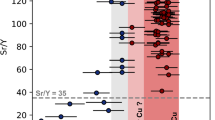Abstract
We are interested in the efficiency of the nonparametric estimation of the conditional quantile when the response variable is a scalar given a functional covariate. To do this, we adopt a technique which is based on the use of the k-Nearest Neighbors procedure to build a kernel estimator of this model. Then, we establish the uniform convergence in number of neighbors of the constructed estimator. Moreover, we discuss the optimal choices of different parameters that are involved in the model as well as the impacts of the obtained results. Finally, we show the applicability and efficiency of our methodology to investigate the fuel quality by using a Near-infrared spectroscopy dataset.




Similar content being viewed by others
Notes
A class of functions \(\mathcal{C}\) is said to be a pointwise measurable class if, there exists a countable subclass \( \mathcal{C}_0 \) such that for any function \( g\in \mathcal{C}\) there exists a sequence of functions \((g_m)_{m\in \mathbf{\hbox {IN}}}\) in \( \mathcal{C}_0\) such that: \(|g_m(z)-g(z)|=o(1)\).
An envelope function G for a class of functions \(\mathcal{C}\) is any measurable function such that: \(\sup _{g\in \mathcal{C}}|g(z)|\le G(z)\), for all z.
References
Al-Awadhi F, Kaid Z, Laksaci A, Ouassou I, Rachdi M (2019) Functional data analysis: local linear estimation of the \(L_1\)-conditional quantiles. Stat Methods Appl 28:217–240
Aneiros G, Cao R, Fraiman R, Vieu P (2019a) Editorial for the special issue on functional data analysis and related topics. J Multivar Anal 170:1–3
Aneiros G, Cao R, Vieu P (2019b) Editorial on the special issue on functional data analysis and related topics. Comput Stat 34:447–450
Benhenni K, Ferraty F, Rachdi M, Vieu P (2007) Local smoothing regression with functional data. Comput Stat 22(3):353–369
Bhattacharya PK, Gangopadhyay AK (1990) Kernel and nearest-neighbor estimation of a conditional quantile. Ann Stat 18:1400–1415
Burba F, Ferraty F, Vieu P (2009) k-nearest neighbor method in functional nonparametric regression. J Nonparametr Stat 21:453–469
Collomb G (1986) Nonparametric time series analysis and prediction: uniform almost sure convergence of the window and \(k\)-NN, autoregression estimates. Math Oper Stat Ser Stat 16:297–307
Einmahl U, Mason D (2005) Uniform in bandwidth consistency of kernel-type function estimators. Ann Stat 33:1380–1403
Ezzahrioui M, Ould Saïd E (2008) Asymptotic results of a nonparametric conditional quantile estimator for functional time series data. Commun Stat Theory Methods 37:2735–2759
Ferraty F, Vieu P (2006) Nonparametric functional data analysis. Theory and Practice. Springer Series in Statistics. Springer, New York
Iglesias-Pérez MC (2003) Estimación de la función de distribución condicional en presencia de censura y truncamiento. Estadíst Española 45:275–301
Kara-Zaïtri L, Laksaci A, Rachdi M, Vieu P (2017) Data-driven \(k\)NN estimation for various problems involving functional data. J Multivar Anal 153:176–188
Koenker R (2005) Quantile regression. Cambridge Books. Cambridge University Press, Cambridge. https://doi.org/10.1017/CBO9780511754098
Koenker RW, Bassett GW (1978) Regression quantiles. Econometrica 46:33–50
Kudraszow N, Vieu P (2013) Uniform consistency of \(k\)NN regressors for functional variables. Stat Probab Lett 83:1863–1870
Laksaci A, Lemdani M, Ould Saïd E (2009) A generalized \(L^1\)-approach for a kernel estimator of conditional quantile with functional regressors: consistency and asymptotic normality. Stat Probab Lett 79:1065–1073
Ling N, Vieu P (2018) Nonparametric modelling for functional data: selected survey and tracks for future. Statistics 52:934–949
Ling N, Aneiros G, Vieu P (2020) kNN estimation in functional partial linear modeling. Stat Pap 61:423–444
Manski C (1985) Semiparametric analysis of discrete response: asymptotic properties of the maximum score estimator. J Econom 27(3):313–333
Messaci F, Nemouchi N, Ouassou I, Rachdi M (2015) Local polynomial modelling of the conditional quantile for functional data. Stat Methods Appl 29(1):597–622
Rachdi M, Vieu P (2007) Nonparametric regression for functional data: automatic smoothing parameter selection. J Stat Plann Inference 137(9):2784–2801
Ramsay JO, Silverman BW (2005) Functional data analysis, 2nd edn. Springer, New York
Shang HL (2016) A Bayesian approach for determining the optimal semi-metric and bandwidth in scalar-on-function quantile regression with unknown error density and dependent functional data. J Multivar Anal 146:95–104
Acknowledgements
The authors are grateful to an anonymous referee and the associate-editor, whose careful reading gave them the opportunity to improve the quality of the first versions of the paper. They are very grateful to the Deanship of Scientific Research at King Khalid University, Kingdom of Saudi Arabia for supporting and funding this work through the research groups program under the Project Number R.G.P.2/68/41.
Author information
Authors and Affiliations
Corresponding author
Additional information
Publisher's Note
Springer Nature remains neutral with regard to jurisdictional claims in published maps and institutional affiliations.
Appendix
Appendix
For the sake of brevity we prove only the Lemma 2. The proof of Lemma 3 is omitted. In fact, it’s similar to that of Lemma 2 in Kara-Zaïtri et al. (2017).
Proof of Lemma 2. We write that
with \(\displaystyle l_n=n^{-1/2}\) and \(d_n=O\left( n^{1/2 }\right) \). Furthermore, the monotonies of \({\mathrm {I\!E}}[\widehat{F }_N(x,\cdot )]\) and \(\widehat{F }_N(x,\cdot )\) imply that for \(1\le j\le d_n\)
It follows that
Then, it is easy to prove that \(\displaystyle l_n^{}=o\left( \frac{\log n}{n\,\phi _x(a_n)}\right) ^{1/2}.\) So, it suffices to show that
To do that we write that
So, all what is left to be shown is to evaluate the following quantity
The proof of the latter follow similar ideas as in Einmahl and Mason (2005) which are based on the Bernstein’s inequality for empirical processes

where \(K_i=K\left( h^{-1}d(x,X_{ i})\right) \). Thereafter, we get
Consequently, an appropriate choice of \(\eta _0\) permits to deduce (3).
Rights and permissions
About this article
Cite this article
Laksaci, A., Ould Saïd, E. & Rachdi, M. Uniform consistency in number of neighbors of the kNN estimator of the conditional quantile model. Metrika 84, 895–911 (2021). https://doi.org/10.1007/s00184-021-00806-5
Received:
Accepted:
Published:
Issue Date:
DOI: https://doi.org/10.1007/s00184-021-00806-5
Keywords
- Almost complete convergence rate
- Functional data analysis
- Functional nonparametric statistics
- kNN method
- Quantile regression
- UNN consistency
- Fuel quality
- Near-infrared spectroscopy




